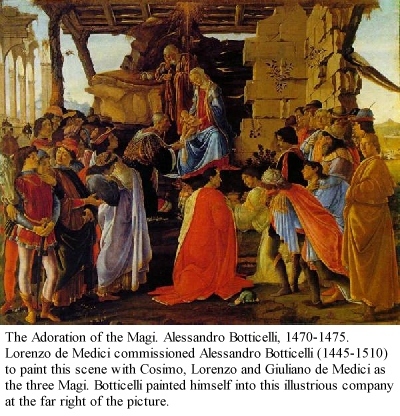End of Europe's Middle Ages

In the late fourteenth century, Giovanni dei Bicci (de Medici) built a network of banks with international business connections that became one of the most powerful financial networks of the time. His eldest son Cosimo continued his father's policies and constructed a widespread base of support using money, marriage and family connections.
While his father had strictly avoided political involvement, Cosimo allied himself with the Albizzi and suffered for the breach in family tradition when he was blamed by them for unpopular tax measures that arose from the Luccan Wars. Cosimo was charged with treason but managed to convince the priors to sentence him to exile instead of death or continued imprisonment. By exercising the political power of his own network, Cosimo managed to have a slate of favourable candidates elected as priors who quickly recalled and exonerated Cosimo, exiling his opponents. At Cosimo's death in 1464, provisions were firmly in place to pass on the control of the family's extensive financial and political power to his heir.
Cosimo's eldest son, Giovanni, died almost immediately and his second son Piero (1464-1469) succeeded to the dynasty. Nicknamed 'Il Gottoso', Piero was handicapped by gout and, though he managed the banking interests well, was merely competent politically. His son, Lorenzo, 'Il Magnifico' (1469-1492), however, was brilliant and ably assisted his father from an early age. As a teenager, Lorenzo was sent on ambassadorial missions to in order to become familiar with the intricacies of Italian diplomacy.
In Italy of the late Middle Ages and early Renaissance, anyone with power had enemies and Lorenzo and his family were no exception. His opposition to attempts by Pope Sixtus VI (1471-1484) to establish a papal state on the frontiers of Florentine territory induced the pope to join forces with the banking rivals of the Medici, the Pazzi family. On April 26, 1478, in an astonishing display of audacity, Lorenzo and his brother, Giuliano, were attacked in the cathedral of Florence during high mass. Lorenzo escaped but Giuliano was mortally wounded. Although Lorenzo avenged the attack, the loss of Giuliano continued to be felt. In much of the artwork that he commissioned in his lifetime, some sort of homage was paid to his dead brother.
Even though he continued the tradition of his father and grandfather by never openly claiming power, Lorenzo had been educated by the finest humanist scholars of the time and was every bit the prince. His patronage of the arts and literature made the Medici court famours throughout Europe. So greatly did Lorenzo expand the prestige of the family that his son, Giovanni, became pope under the name Leo X (1513-1521), his nephew, Giuliano, became Pope Clement VII (1523-1534) and his great-granddaughter, Catherine (1519-1589), became the Queen of France through her marriage in 1533 to Henry II of France. By the beginning of the seventeenth century, nearly every ruling house in Europe was related to the Medici.
 |
Return to Italy's City-States |
The End of Europe's Middle Ages / Applied History Research Group / University of Calgary
Copyright © 1997, The Applied History Research Group